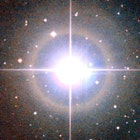Lacerta–Vulpecula
Constellations – 2
Ian Ridpath (Member, IAU Working Group on Star Names)
Constellation
Genitive
Abbr.
Area
(square
degs.)
Area
of sky
(%)
Order
of
size
Visibility range
(full)
Visibility range
(partial)
Number
of stars
≤ 6.5*
Lacerta
Lacertae
Lac
200.7
0.486
68
90°N – 33°S
33°S – 54°S
68
5
Leo
Leonis
Leo
947.0
2.296
12
82°N – 57°S
57°S – 90°S
123
1
Leo Minor
Leonis Minoris
LMi
232.0
0.562
64
90°N – 48°S
48°S – 67°S
37
5
Lepus
Leporis
Lep
290.3
0.704
51
62°N – 90°S
79°N – 62°N
73
1
Libra
Librae
Lib
538.1
1.304
29
60°N – 90°S
89°N – 60°N
83
1
Lupus
Lupi
Lup
333.7
0.809
46
34°N – 90°S
60°N – 34°N
127
1
Lynx
Lyncis
Lyn
545.4
1.322
28
90°N – 28°S
28°S – 57°S
97
5
Lyra
Lyrae
Lyr
286.5
0.694
52
90°N – 42°S
42°S – 64°S
73
1
Mensa
Mensae
Men
153.5
0.372
75
5°N – 90°S
20°N – 5°N
22
6
Microscopium
Microscopii
Mic
209.5
0.508
66
45°N – 90°S
62°N – 45°N
43
6
Monoceros
Monocerotis
Mon
481.6
1.167
35
78°N – 78°S
90°N – 78°N,
78°S – 90°S
138
4
Musca
Muscae
Mus
138.4
0.335
77
14°N – 90°S
25°N – 14°N
62
3
Norma
Normae
Nor
165.3
0.401
74
29°N – 90°S
48°N – 29°N
44
6
Octans
Octantis
Oct
291.0
0.706
50
0° – 90°S
25°N – 0°
60
6
Ophiuchus
Ophiuchi
Oph
948.3
2.299
11
59°N – 75°S
90°N – 59°N,
75°S – 90°S
174
1
Orion
Orionis
Ori
594.1
1.440
26
79°N – 67°S
90°N – 79°N,
67°S – 90°S
204
1
Pavo
Pavonis
Pav
377.7
0.915
44
15°N – 90°S
33°N – 15°N
87
3
Pegasus
Pegasi
Peg
1120.8
2.717
7
90°N – 53°S
53°S – 87°S
177
1
Perseus
Persei
Per
615.0
1.491
24
90°N – 31°S
31°S – 59°S
158
1
Phoenix
Phoenicis
Phe
469.3
1.138
37
32°N – 90°S
50°N – 32°N
71
3
Pictor
Pictoris
Pic
246.7
0.598
59
26°N – 90°S
47°N – 26°N
49
6
Pisces
Piscium
Psc
889.4
2.156
14
83°N – 56°S
56°S – 90°S
150
1
Piscis Austrinus
Piscis Austrini
PsA
245.4
0.595
60
53°N – 90°S
65°N – 53°N
47
1
Puppis
Puppis
Pup
673.4
1.632
20
39°N – 90°S
78°N – 39°N
237
7
Pyxis
Pyxidis
Pyx
220.8
0.535
65
52°N – 90°S
72°N – 52°N
41
6
Reticulum
Reticuli
Ret
113.9
0.276
82
23°N – 90°S
37°N – 23°N
23
6
Sagitta
Sagittae
Sge
79.9
0.194
86
90°N – 69°S
69°S – 73°S
26
1
Sagittarius
Sagittarii
Sgr
867.4
2.103
15
44°N – 90°S
78°N – 44°N
194
1
Scorpius
Scorpii
Sco
496.8
1.204
33
44°N – 90°S
81°N – 44°N
167
1
Sculptor
Sculptoris
Scl
474.8
1.151
36
50°N – 90°S
65°N – 50°N
52
6
Scutum
Scuti
Sct
109.1
0.264
84
74°N – 90°S
86°N – 74°N
29
5
Serpens
Serpentis
Ser
636.9
1.544
23
Serpens Caput:
86°N – 64°S
Serpens Cauda:
73°N – 83°S
Serpens Caput:
90°N – 86°N,
64°S – 90°S
Serpens Cauda:
90°N – 73°N,
83°S – 90°S
108
1
Sextans
Sextantis
Sex
313.5
0.760
47
78°N – 83°S
90°N – 78°N,
83°S – 90°S
38
5
Taurus
Tauri
Tau
797.2
1.933
17
88°N – 58°S
58°S – 90°S
223
1
Telescopium
Telescopii
Tel
251.5
0.610
57
33°N – 90°S
44°N – 33°N
57
6
Triangulum
Trianguli
Tri
131.8
0.320
78
90°N – 52°S
52°S – 64°S
25
1
Triangulum Australe
Trianguli Australis
TrA
110.0
0.267
83
19°N – 90°S
29°N – 19°N
35
3
Tucana
Tucanae
Tuc
294.6
0.714
48
14°N – 90°S
33°N – 14°N
45
3
Ursa Major
Ursae Majoris
UMa
1279.7
3.102
3
90°N – 16°S
16°S – 62°S
209
1
Ursa Minor
Ursae Minoris
UMi
255.9
0.620
56
90°N – 0°
0° – 24°S
39
1
Vela
Velorum
Vel
499.6
1.211
32
32°N – 90°S
52°N – 32°N
214
7
Virgo
Virginis
Vir
1294.4
3.138
2
67°N – 75°S
90°N – 67°N,
75°S – 90°S
169
1
Volans
Volantis
Vol
141.4
0.343
76
14°N – 90°S
25°N – 14°N
31
3
Vulpecula
Vulpeculae
Vul
268.2
0.650
55
90°N – 61°S
61°S – 71°S
68
5
* NOTES ON COLUMN HEADINGS:
Visibility range (full) gives the range of latitudes from which each constellation rises fully above the horizon at some time. Stars close to the horizon will be considerably dimmed by atmospheric extinction.
Visibility range (partial) gives the latitudes from which the constellation only ever rises partly above the horizon. Constellations which never rise more than a few degrees above the horizon from a given latitude will be effectively unobservable.
Number of stars ≤6.5 gives the number of stars within the constellation of magnitude 6.5 and brighter as listed in the Hipparcos Catalogue.
Origin:
1. Original Greek constellations listed by Ptolemy in the Almagest
2. Considered by the Greeks as part of Leo; made separate by Caspar Vopel in 1536, followed by Gerardus Mercator in 1551.
3. The 12 southern constellations of Pieter Dirkszoon Keyser and Frederick de Houtman
4. Constellations added by Petrus Plancius
5. Seven constellations of Johannes Hevelius
6. The 14 southern constellations of Nicolas Louis de Lacaille
7. Part of the original Greek constellation Argo Navis, dismantled in the 18th century by Nicolas Louis de Lacaille.
Who were Ptolemy, Keyser, de Houtman, Plancius, Hevelius, and Lacaille? For more on the origin and originators of the constellations, see Chapter One of Ian Ridpath’s Star Tales.

